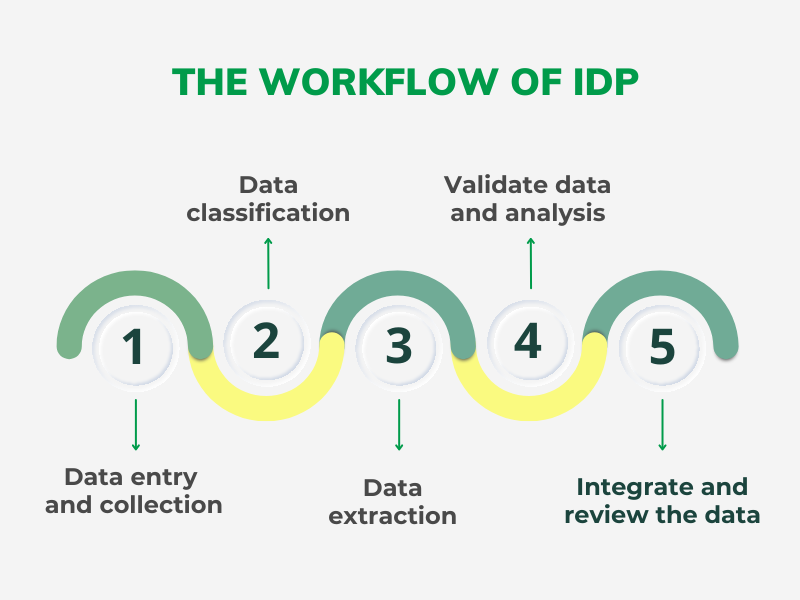Resources > Blog > 2> Unlocking Business Efficiency: Benefits of IDP
Unlocking Business Efficiency: Benefits of IDP
What is IDP?
The workflow of IDP
Intelligent Document Processing (IDP) is a multi-step process that converts unstructured and semi-structured documents into data. Here are some typical stages of an IDP workflow that will enhance business efficiency.

Data entry and collection
The first step in Intelligent Document Processing is gathering data from multiple sources with various formats, such as PDFs, Word documents, and email. By leveraging the benefits of IDP technologies in this process, the IDP will capture and ingest the data into the system. Once the document enters the IDP workflow, document pre-processing begins, which includes fundamental techniques like binarization, deskewing, and messy clean up.
Data classification
Before moving to information analysis, document classification will go through the step of determining the starting and ending points of the data. This process involves categorizing various document types, such as invoices, purchase orders, identity documents, contracts, bills,…. If the source material is a PDF or a scanned image, the IDP workflow utilizes Optical Character Recognition (OCR) technology to analyze the content by extracting characters, numbers, and symbols. Then, the IDP system intelligently sorts these documents into categories for further processing.
Data extraction
Data extraction is the most crucial stage of Intelligent Document Processing (IDP), following file type classification and data source format analysis. This process leverages machine learning (ML), deep learning (DL), and natural language processing (NLP) techniques to accurately extract relevant data from documents. The trained AI models are utilized to identify and retrieve specific aspects of information, such as addresses, tax information, monetary values, product technical specifications,…. With advanced machine learning methods, the high accuracy extracted data is then structured and entered into databases or stored for future use. Thereby, enhancing data accessibility and usability for business efficiency.
Validate data and analysis
The data validation step involves applying a series of checks and rules to confirm that the data meet the predefined standards and are consistent with the external sources. By harnessing the benefits of IDP technologies during validation, data is cross-referenced with external databases to verify its correctness. The process also includes rule-based validation, where data is checked for format, range, and completeness, ensuring that all required fields are present and correctly filled. Additionally, consistency checks are performed to ensure uniformity across documents, and any discrepancies or errors are flagged for correction.
Integrate and review the data
Data integration involves seamlessly merging the validated and structured data into an organization’s existing systems and applications. This includes mapping and transforming the data to match the formats of the systems business using, and then uploading the data on the systems. A human-in-the-loop review is also incorporated in this step to improve data accuracy, which not only enhances the supervised learning process of the model but also increases its overall reliability and business efficiency.
What benefits of IDP will make better business efficiency?

Optimize operational process
One of the benefits of IDP is make operational process become more effective. As business are facing a large amount of data in their daily work, efficient and smooth data extraction form various documents and formats become more and more significant. IDP offer a streamlined extraction by automating the extraction process, allowing businesses avoid the time-consuming and reduce manual data entry processes. This automation will not only reduce the likelihood of error and inaccuracies, but also free up employee to concentrate on more strategic tasks.
Operation cost reduction
Benefits of IDP also demonstrated through eliminating human need for manual data entry and verification. When the labor is significantly minimized, the operation cost related to document handling, data entry, and validation can be reduced. Additionally, IDP also streamlines workflows, leading to increase business efficiency and productivity, which further contributes to costs saving.
Get better resources allocation
Enhance data accuracy
Ensure compliance and security
IDP systems will include advanced encryption and access control measures, safeguarding sensitive information from unauthorized access. They can also maintain detailed audit trails, providing a clear record of who accessed or modified the data, which is crucial for meeting regulatory requirements. Additionally, IDP helps organizations to consistently apply data retention policies, ensuring that documents are stored for the required duration and securely disposed of when no longer needed.
Effective Document Management and Storage
IDP significantly improves document management and storage by automating the extraction, classification, and organization of information. By converting unstructured data into structured formats, IDP systems streamline the process of indexing and storing documents, making them easily retrievable and manageable. Additionally, IDP systems can integrate with existing digital storage solutions, ensuring that all documents are securely stored and easily accessible. This benefits of IDP will leads to more increase business efficiency, improved compliance with data management regulations, and a reduction in storage costs.



 Previous Post
Previous Post Next Post
Next Post



